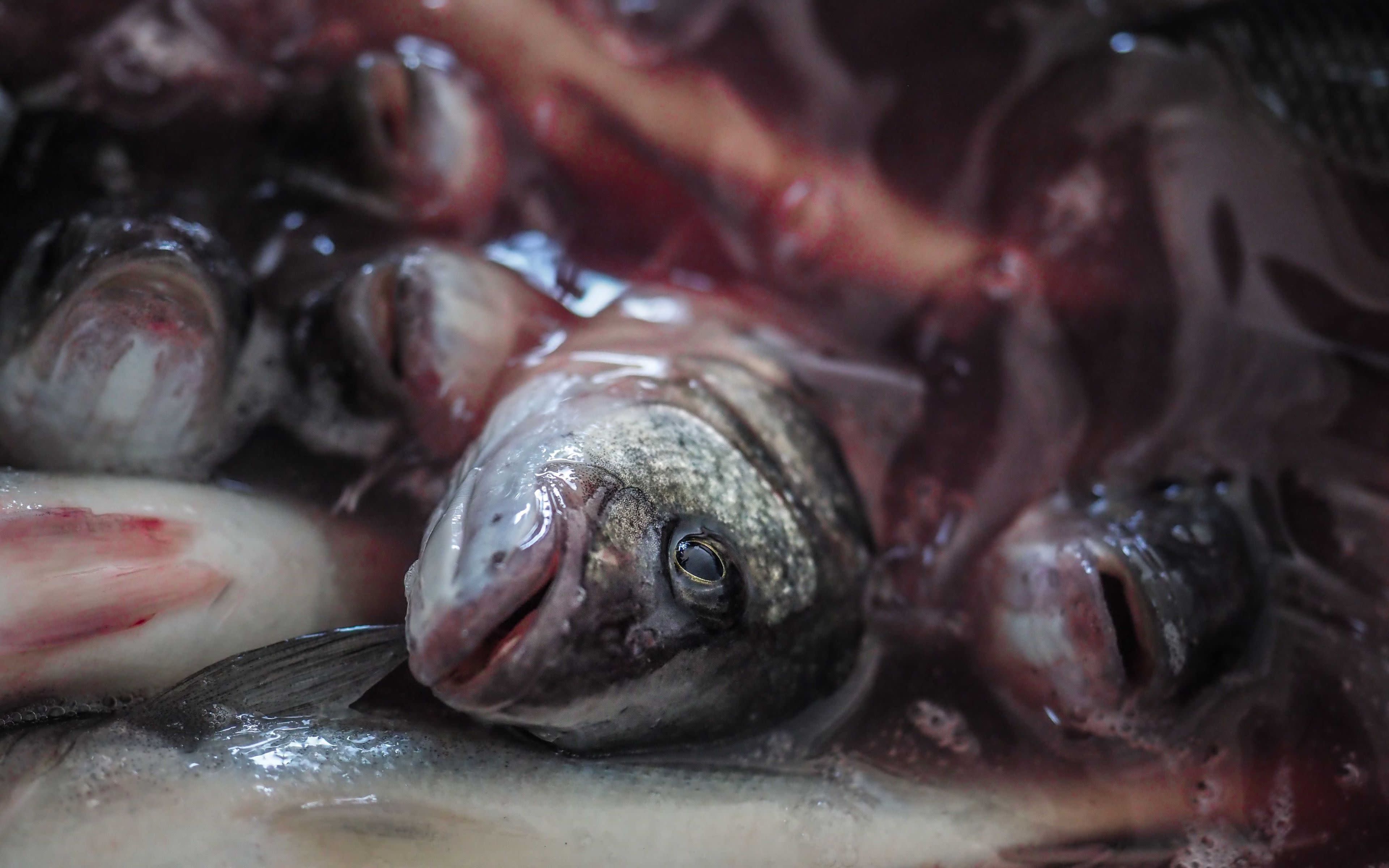




Scientific evidence suggests that fish feel pain. Their complex nervous systems and behaviors challenge long-held beliefs that fish can be treated with no regard for their welfare.

There’s a prevailing misconception that fish are nothing more than streams of protein swimming mindlessly in the oceans and rivers of the world, possessing nervous systems and brain structures that weren’t complex enough to experience pain the way that humans do. Because of these perceived deficiencies, fish go through immense amounts of pain and suffering—especially in the fishing industry.
In recent decades, scientific evidence has dispelled the myth that fish don’t feel pain. Now, after mounting discoveries of pain receptors, complex nervous systems, and evolving notions of consciousness, people are giving fish a second thought when it comes to how they're used, raised, caught, and killed.
Do fish feel pain when hooked?
The wild wriggling and squirming fish do when they're hooked and pulled from the water during catch-and-release fishing isn't just an automatic response—it's a conscious reaction to the pain they feel when a hook pierces their lips, jaws, or body. One study looked at the faces and heads of rainbow trout who were hooked during angling, finding 22 receptors on the lips, jaws, and around the eyes that are likely associated with pain. In another study, researchers injected the lips of fish with an acidic substance. The fish swam slower, decreased social activities, delayed eating, and rubbed their lips against the glass walls of the tank or in the sand along the bottom. Considering that fish have a high concentration of nociceptors—sensory receptors for painful stimuli—inside their mouths and on their lips, it’s no wonder that a hooking injury can be devastating for a fish.
Do fish feel pain when they suffocate?
Fish out of water are unable to breathe, and they slowly suffocate and die. Just as drowning is painful for humans, this experience is most likely painful for fish. Compounds like cortisol—the hormone associated with stress—can significantly increase during periods when fish are out of water. For some species, suffocation takes a very long time. One study found that cod and haddock often remain conscious on the decks of fishing ships for two hours or more—an unnecessarily prolonged period of suffering that goes against humane fish welfare standards.
Just as drowning is painful for humans, this experience is most likely painful for fish.
This prolonged period of suffering is made worse if a fish is already injured, which is often the case given the methods commonly used by the commercial fishing industry. Within fisheries such as bottom trawling and purse seining, huge numbers of fish are crushed together as they are brought aboard processing vessels. For other fishing techniques like pole and line, the cheeks, lips, jaws, and other places of fish are pierced with hooks, and large fish are sometimes stabbed as they are brought on board.
Why do people believe that fish don't feel pain?
A visit to the doctor for pain-related issues often includes the physician asking the question: "On a scale of one to ten, how bad does it hurt?" This basic assessment of pain hasn’t been updated since the dawn of modern medicine because, quite simply, it can’t be. Pain is an emotional, subjective experience that is hard to quantify, leading to all kinds of biases throughout the medical system, including racial and gender biases.
Because fish cannot answer the doctor’s question—or put another way, because humans cannot speak to fish—these animals aren’t able to tell us whether they experience pain. This inability to understand each other is what grounds the disbelief in fish pain, and animal pain more broadly.
Evidence that fish experience pain
Pain comes in two forms: physical and emotional. While not generally accepted by the public (although the scientific community mostly agrees on the subject), there is increasing evidence that fish can experience psychological pain arising not from physical injury but from emotional states.
Scientists once believed that only “higher-order” animals such as humans, other primates, and select species like dolphins could experience emotional pain. They point to the possession of the neocortex, a part of the brain associated with more sophisticated cognitive processes, as proof. In recent years, however, emotional pain has been documented in a wide variety of animals, including fish, despite their lack of a neocortex.
As for physical pain, the anatomical structure of fish leaves little room for doubt regarding the ability of fish to suffer. So, even if their experiences of pain or suffering may not look exactly like our experiences, the evidence is clear—fish feel pain and suffer, too.
Peripheral nervous system
The nervous system consists of a complex network of nerves found throughout the body, and transmitter cells, called neurons, that deliver signals to nerves. This system is required for all bodily functions, akin to an electricity grid powering a city. The nervous system consists of two parts: central, located in the brain and spinal cord; and peripheral, located in other parts of the body. Together, these two systems work to generate responses to all sorts of stimuli, including pain.
Like other vertebrates species, fish possess both of these systems. Therefore, they have the capacity to feel pain through their peripheral nervous system.
Receptors
Pain receptor neurons, known as nociceptors, exist in the peripheral nervous system and are sensitive to stimulation in both humans and fish. Nociceptors generate an automatic, instinctive response to pain—like when you touch a hot object, causing your hand to pull back even before pain is consciously registered. Nociceptors have been found distributed across the bodies of certain fish species, with high concentrations around the fins, tail, eyes, and nostrils.
Nerve fibers
Nerve fibers transmit neurons from pain receptor sites to other parts of the nervous system to generate a further response. In fish, two kinds of nerve fibers transmit pain impulses. A-delta fibers signal acute pain, pressure, and cold stimulus; whereas Group C fibers are associated with a severe injury. In humans, Group C fibers often signal pain from toothaches and burns.
Central nervous system
As with all invertebrates, the central nervous system of fish is composed of the spinal cord and brain, into which signals from the peripheral nervous system are delivered. Conscious processing of painful stimulation occurs in the brain, which can then trigger the opioid system and other protective responses described below.
Brain
If we touch a hot object, our hand automatically withdraws as nociceptors register the burn. But we don’t consciously register pain until neural signals travel along nerves into the brain. This process is the same in fish and other invertebrates.
While there has long been skepticism as to whether these signals are registered within parts of the brain other than the thalamus, which controls motor functions, more recent studies have found that the forebrain areas of some fish species showed similar reactions to those of the human brain when enduring pain.
Opioid system
In humans and other mammals, opioids are produced by the body in response to pain, so the fact that fish also produce opioids is further evidence that they consciously experience pain. Synthetic opioid drugs—including morphine, oxycodone, and heroin—are designed to mimic these natural pain killers. These drugs are known to work on fish as well.
Fish have been observed rocking back and forth, losing their appetite, becoming withdrawn, hyperventilating, and changing their habitual swimming activity.
Protective responses
Protective responses are behaviors that injured animals engage in as a way to self-soothe, reduce pain, or promote healing. Several studies have been conducted illustrating various protective responses in fish who have been injured under experimental conditions. Fish have been observed rocking back and forth, losing their appetite, becoming antisocial and withdrawn, hyperventilating, and changing their habitual swimming activity.
Yes, fish feel pain
A significant body of scientific evidence suggests that yes, fish can feel pain. Their complex nervous systems, as well as how they behave when injured, challenge long-held beliefs that fish can be treated without any real regard for their welfare. The American Veterinary Medical Association states in their guidelines for euthanizing animals that fish “should be accorded the same considerations as terrestrial vertebrates in regard to relief from pain.”
You can help
Unfortunately, the commercial fishing industry and factory fish farms force fish to endure cruel treatment every day. Research continues to confirm that fish have feelings just like we do, and they deserve better than a life of suffering. Join thousands of other compassionate advocates in fighting back against the fishing industry's animal cruelty.







